| Reviews & Columns |
|
Reviews DVD TV on DVD Blu-ray 4K UHD International DVDs In Theaters Reviews by Studio Video Games Features Collector Series DVDs Easter Egg Database Interviews DVD Talk Radio Feature Articles Columns Anime Talk DVD Savant Horror DVDs The M.O.D. Squad Art House HD Talk Silent DVD
|
DVD Talk Forum |
|
|
| Resources |
|
DVD Price Search Customer Service #'s RCE Info Links |
|
Columns
|
|
|
Eagle Eye: Two-Disc Special Edition
Dreamworks // PG-13 // December 27, 2008
List Price: $34.98 [Buy now and save at Amazon]
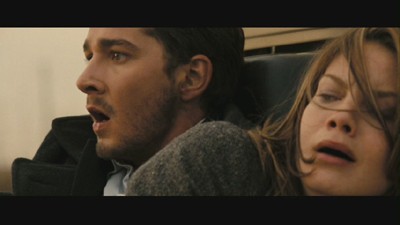
The Film:
I was almost begging for the female electronic voice in Eagle Eye to blurt out in a sensuous, digitally-garbled voice, "Shall we play a game?" This Shia LaBeouf vehicle certainly feels like a giant game -- similar to Fincher's The Game, or John Badham's WarGames for that matter -- one that should be taken about as seriously as anything with a PlayStation logo slapped on its cover. After early word spread that the script was a tad sharper than your average summer blockbuster, many a filmgoer had high hopes for this to transform into a popcorn flick with a brain and a message. Only meeting expectations halfway by projecting Big Brother as a renegade tool, Disturbia's D.J. Caruso has designed an actioner that tosses logic, physics, and reason out the window to create a nonsensical blur of hyper-stylized explosions and overclocked jabs at tension. Eagle Eye is smart in concept, but over-processed and irrational in follow through.
We begin with Jerry Shaw (Shia LaBeouf, Indy IV) not having the greatest of days. Though it starts with him taking his Copy Cabana (read: mini Kinko's clone) co-workers for a ride around the poker table, he soon finds himself swimming in nuclear weapons and assorted artillery in the apartment that he's soon to be evicted from -- shortly after he discovers that his military twin brother Ethan has been killed. Then, the phone rings: on the other end is a female voice, sharp and to the point when it informs him that he'll be arrested by the FBI if he doesn't vacate the premises. Rachel Hollowman (Michelle Monaghan, Mission: Impossible III), a newly divorced mother, receives a similar call across town that threatens the life of her son if she fails to cooperate with the voice's commands. No questions are to be asked or answered, just for the two to follow an intricate travel regiment filled with strategically malfunctioning cameras, coordinated traffic lights, and remote-guided vehicles that guide them to their presumably dangerous destination.
Shia LaBeouf holds his own as the hero/anti-hero amid Eagle Eye's core, much more so than he does with Transformers. His mild asinine demeanor is certainly preferable over his attempts at worming into audience favor, though he's still missing something that sells himself as an action star. Michelle Monaghan helps fill in any gaps with her natural charisma, something she's become accustomed to doing after blotting here and there around Robert Downey Jr. in Kiss Kiss, Bang Bang and walking pace-for-pace with Casey Affleck in Gone Baby Gone. Thankfully, both steer clear of delving into a romantic connection, because there's barely enough of a survival instinct's chemistry between them to connect their forefront character development to all the volatile chaos they'll soon endure.
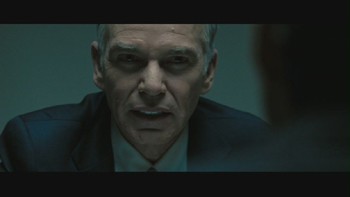 | 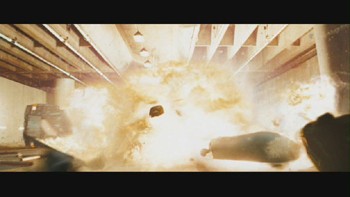 |
Most of the material covered in Eagle Eye's trailer was scooped up from its top layer, which shows how promising this idea could have been. It blends government miscommunication -- led by Billy Bob Thornton's (Friday Night Lights) always satisfying aggressiveness, but also accompanied by a largely wasted performance from Michael Chiklis ("The Shield") and a miscast fizzle from Rosario Dawson (Sin City) -- with the manipulation of our convenient monitoring tools to benefit an outside source. There's a lot of mileage made to cover in its initial brainstorms, but it lacks concept reinforcement as the minutes tick away. Interestingly, 2001: A Space Odyssey, a film forty (!) years Eagle Eye's senior, teaches a lot more about placing too much faith in technology; it let us know that computers could be manipulated (or develop themselves) to serve a smorgasbord of purposes, sometimes on misguided principles that could damage the denizens reliant on its mechanics. In an age where society has turned into a technology-bound Discovery One as a whole, it's not all that surprising to see Dan McDermott's story use this real context to fuel a chunk of mainstream fare with miles-a-minute conspiracy energy.
One of these exciting blasts must have jarred Eagle Eye's perception of reality early on, because it dives into a deep vat of disbelief right around the time it cracks open Pandora's Box and lets all its secrets sputter out. Not that the twist catalyzes the downward spiral, which it doesn't -- well, not really; this big reveal just so happens to parallel with the moment that Caruso slams his foot on the gas to rustle up as many plot-centric throttle blasts that two hours can handle. "Pushing the envelope" comes to mind, since Eagle Eye illustrates the aftereffects when forgets about the envelope's integrity and crank out a mixed bag of pyrotechnics and computer-generated effects work. A scene with a Jeep, a stealth reconnaissance plane, a heavily-populated tunnel, and a piece of mangled structural metal comes to mind, one of the many exercises in logistical cinema that'll shoot a question mark above anybody's head with a grasp on common sense.
In design, it's all somewhat reminiscent of the architecture within Michael Bay's sci-fi The Island -- an admitted guilty pleasure of mine -- because of its clear segmentation between well-engineered plotting and carefree explosiveness. Bay's film becomes a modernized rendition of George Lucas' THX 1138, and then goes into Michael Bay land by frittering away dollar after dollar to create all the explosions and craziness that build its redeeming mushroom cloud of a conclusion. Similarly, Eagle Eye certainly has ambition with its larger-than-life Big Brother concepts, but it quickly dilutes them with all its highly-explosive, stylish bombast hobbling on a broken leg of logic. All this disbelief and intellect-backstabbing behind product-placement fanfare and dimwitted common sense can't be ignored enough to soak in all its doses of adrenaline, even though it handles it all with plenty of Hollywood polish that dresses it to be like WarGames for a new generation. But it's void of a timely message behind its heavily emphasized material, unless you count the "message" sent through the fact that this anecdote has been rehashed repeatedly since the late '60s in one form or another. Thankfully, Eagle Eye's still entertaining enough to plow through -- just be sure to check your cranial luggage at the door.
The DVD:
 | 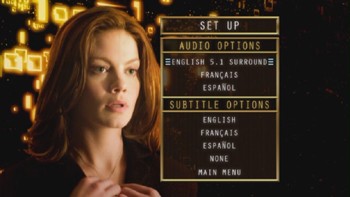 |
As per Paramount/DreamWorks's regular efforts for two-disc sets as of late, they've sent us their copy of Eagle Eye:2-Disc Special Edition with a nice embossed slipcover that replicates the attractively-designed artwork. Once again, silver discart and a lack of chapter listing neglect to help out the physical presentation. Still, the glossy slipcover is a slick addition.
Video and Audio:
All points considered, Eagle Eye is a pretty dark film. Therefore, handling black levels becomes an important aspect in bringing this 2.35:1 image to home entertainment. Paramount's 16x9 enhanced transfer does a fine job of doing that, though it shows minor bits of pixelation and noise in some darker patches. Details, like facial textures in its countless close-ups and intricacies within complex backdrops at a waste disposal plant, show off a substantial level of intricacy that's pleasant to the eye. I did spot a few instances of aliasing in some shots, namely on LaBeouf's eyelids at one point, as well as some muddy, digitized facial features in mid-range dialogue shots. Overall, this transfer supports all the film's loud activity by keeping up with the pace during the scenes where it really matters. It could be better, but what we've got plays well with the material.
For an action film, however, Eagle Eye sounded surprisingly mediocre in its Dolby Digital 5.1 presentation. It flexes some rear channel usage in a few spots, but the level of verbal clarity could've been a bit better -- especially in a few of Thornton's scenes. Most importantly, one or two explosions sounded like they slammed against the track's ceiling a few times, sounding flat when they reached a certain volume level. In spite of that, the LFE channel does get a solid workout more often than not, while most mid-range sound effects poured through the speakers quite well. It's a fine audio treatment, but it certainly highlights where the track maxes out when it shouldn't. French and Spanish language tracks are also available, as are optional subtitles in all three languages.
Special Features:
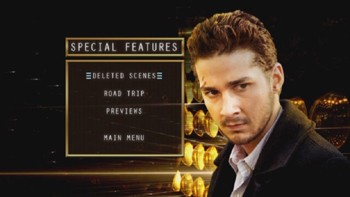 | 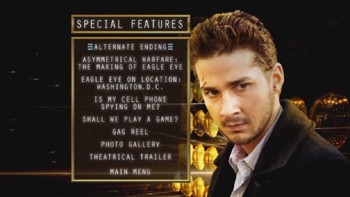 |
Road Trip (3:04):
As a quick overview assembly feature, this blasts through the generic stuff in rapid fashion. Actually, it's redundant after you've seen the special features from Disc 2 since the majority of the interview and behind-the-scenes material is taken from featurettes on the second disc.
Disc One also includes three minutes of Deleted Scenes (3:36) and a set of Previews.
Disc Two:
Alternate Ending (1:07):
Lasting only a hair over a minute, this ending picks up right after the theatrical ending left off. It doesn't change anything, narrative-wise or anything, just shows the children playing Rock Band for about 45 seconds -- followed by some strange text that covers the screen. Whoever decided this was not the right way to leave the audience was 100% in the right.
Asymmetrical Warfare: Making of Eagle Eye (25:30):
Though it's set up like every other assembly featurette you'll see, this piece actually goes splendidly in-depth to the production of Eagle Eye. At most points during its runtime, the traditional interview material falls into a pseudo-PiP mode with the footage playing at another quadrant on the screen. That keeps interest locked onto all of the work discussed -- explosives, actor influences, blue-screen work, producer input, etc. Moreover, it never seems like the interviews approach "back-slapping" all that much, instead feeling very earnest and open.
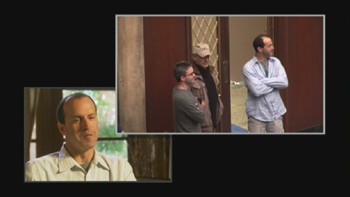 | 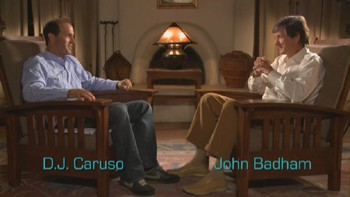 |
Eagle Eye on Location: Washington D.C. (5:58):
Here, we've got more behind-the-scenes footage that clarifies which portions were shot on-set and which ones were filmed at actual D.C. locales. It captures several shots at the Capital and Library of Congress, as well as giving some history as to how the two will be "connected" soon. Furthermore, there's some time spent at the Pentagon.
Is My Cellphone Spying on Me? (9:14):
The reality behind all the spy technology utilized in the film falls under focus here, though not necessarily focusing on just cell phone tech. The best part of this featurette comes in the actors interpretations and personal feelings about the exploitation of monitoring technology -- especially the little imprints left by Chiklis and Monaghan on the subject. Furthermore, there's some interesting discussion on the omnipresent proposed banning of security cameras, focusing on how they violate our Constitutional laws.
Shall We Play a Game? (9:22):
Here, D.J. Caruso sits down with his mentor, WarGames director John Badham. They discuss lighting, pre-visualization work, the blending of special effects and reality, as well as the chief differences between WarGames and Eagle Eye -- which are far less numerous than their similarities.
We've also got a seven minute Gag Reel (7:00), a Photo Gallery, and the anamorphic Theatrical Trailer that circulated heavily early in the summer of '08.
Final Thoughts:
If you'd like to see WarGames, only with things that go BOOM in blockbuster fashion, then give its clearly-influenced Eagle Eye a spin. LaBeouf and Monaghan both do an admirable job of giving this blend of real-time tech and outlandish action some personality at the head, though the technology aspects of the narrative that they carry on their shoulders deconstruct into sequences heavily saturated in disbelief and ridiculousness. Still, it's entertaining enough to give it a whirl -- not as any kind of profound Big Brother message, but as a non-stop action flick perfectly accompanied with a bowl of Act II or Orville Redenbacher. Paramount's DVD does a suitable enough job with the special features (especially with a great making-of featurette) though they feel a anemic in size. Overall, this package is one that's worth a Rental for a night or two of check-your-brain-at-the-door intensity.
|
| Popular Reviews |
| Sponsored Links |
|
|
| Sponsored Links |
|
|
| Release List | Reviews | Shop | Newsletter | Forum | DVD Giveaways | Blu-Ray | Advertise |
|
Copyright 2024 DVDTalk.com All Rights Reserved. Legal Info, Privacy Policy, Terms of Use,
Manage Preferences,
Your Privacy Choices | |||||||













